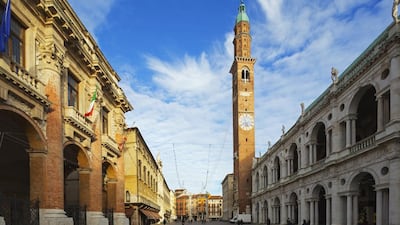David Whitley
Why Vicenza?
Few people have had as great an influence on architecture as Andrea Palladio. The Italian’s admiration for the symmetry and form of ancient temples inspired great buildings around the globe, whether the facade of Buckingham Palace in London or Thomas Jefferson’s Monticello. But the place where it started – home to the greatest concentration of his works – is the small northern Italian city of Vicenza.
Sandwiched between big-hitting Venice and Verona, Vicenza regularly finds itself skipped through on a train. But given the chance, it’s one of those cherished finds. The city centre is small, mostly pedestrianised and delightfully walkable. Palladio’s sumptuous architecture can be taken as a given, but what strikes is how harmonious and elegant it looks as a whole.
A comfortable bed
The eight-bedroom Relais Santa Corona (www.relaissantacorona.it) has large walk-in showers, heated towel rails and a few design touches to add to the cosiness. Double rooms cost from €108 (Dh418).
Packing in far more flair, however, is the G Boutique Hotel (www.gboutiquehotel.com), where a chess set, piano and chandeliers congregate in the moodily low-lit lobby. Feature walls in the rooms look like either bookshelves or stamp albums, and all the technology is in the right place – handy in a country where plugs by the bed can be infuriatingly absent. Doubles costs from €149 (Dh576).
The predictably named Hotel Palladio (www.hotel-palladio.it) keeps a lot of the building's historic features, such as the gorgeous gnarled wood ceilings. But it has a contemporary flair, sometimes extended to frosted glass shower cubicles within plain sight of the bed (although each room is different). Rooms cost from €160 (Dh619).
Find your feet
Start at the Palladio Museum (www.palladiomuseum.org) to delve into the history of a miller's son who became an agenda-setting, visionary architect. It also gives a good grounding of the principles – often formulated on trips to ancient Roman sites – that went into Palladio's work.
From there, amble around some of his inner-city buildings, including the Palazzo Capra, Palazzo Thiene and Palazzo Chiericati. The two stars, however, are the Basilica Palladiana and Teatro Olimpico (www.teatrolimpicovicenza.it).
The former was the mall of its day, and shops are still found in the arches of the lower loggia. The first floor, however, is now home to the Museo del Gioiello (www.museodelgioiello.it) which has some astonishingly fine examples of the jeweller's art – the Van Cleef functioning zip made from gold and diamonds that can be either necklace or bracelet is particularly ingenious.
The Teatro Olimpico is in a league of its own. It looks like a marble temple, but everything is faked in wood. And the intricately detailed streetscape set behind it, using clever perspective to make it look much bigger than it is, has been in place since the first-ever production, staged in the 16th century.
Meet the locals
Bar Borsa (www.barborsa.com), in an arcade-like tunnel that goes through the middle of the Basilica Palladiana, is a jazz joint that manages to be both atmospheric and fun. The piano and old black-and-white photos inside contrast with the tables spread under the arch outside – which are particularly buzzy when it's raining, but people don't want to give up on the al fresco vibe.
Book a table
For a lunch stop, Il Ceppo (www.gastronomiailceppo.com) on Corso Palladio is a deli right from the top league, as the queues outside will testify. Everything is priced by the kilo, whether roast beef slices, torteloni or the local cod dish, baccalà alla Vicentina. Not a single option looks less than drool-provokingly stellar.
Antica Casa Della Malvasia (www.anticacasadellamalvasia.it), with its exposed stone arches and odd tribal sculptures, offers something different. That extends to the menu, where the likes of the €13 (Dh50) couscous with lamb, artichokes, Greek yogurt and dates diverge from the regional standards.
Shopper’s paradise
The main street – Corso Palladio – is lined with shops; some high-street chains, some discerning Italian couture chic. But veer off it for the Cappelleria Palladio on Piazzetta Andrea Palladio – a fabulous hat shop of fur, feathers and fascinators, that does a roaring trade come Venice Carnival time.
In the Basilica Palladiana, Soprana is a local legend on the jewellery front. Expect to see high-class watches, earrings, necklaces and rings, plus a lovely range inspired by Palladio’s designs.
What to avoid
The Museo Naturalistico Archeologico (www.museicivicivicenza.it/it/mna) manages to be dull, even by the standards of Italian archaeological museums. And Italy has no shortage of chronically dull archaeological museums.
Don’t miss
A pleasant couple of kilometres’ walk south of the city centre, La Rotonda (www.villalarotonda.it) is arguably the perfect representation of Palladio’s vision. Totally symmetrical, with four identical facades and a dome topping it off, it’s a design that has been adopted and adapted around the world.
Getting there
Etihad (www.etihad.com) and Emirates (www.emirates.com) fly direct from Abu Dhabi and Dubai respectively to Venice from Dh2,520 return, including taxes. The flight takes six hours. Atvo (www.atvo.it) runs €8 (Dh31) buses from the airport to Venice Mestre Train Station, taking about 20 minutes. From there, regular trains (www.trenitalia.com) go to Vicenza, taking about an hour and costing about €5 (Dh19).

